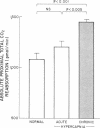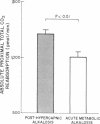Abstract
The hyperbicarbonatemia of chronic respiratory acidosis might be maintained by a reduction in filtration rate or an enhancement of tubular bicarbonate reabsorption. To investigate this question, 12 Munich-Wistar rats were exposed to a 10% CO2 atmosphere for 6-8 d. Chronic respiratory acidosis developed, with arterial pH 7.30 +/- 0.01, partial pressure of CO2 (pCO2) 80 +/- 2 mmHg, and total CO2 concentration 45 +/- 1 mM. Single nephron glomerular filtration rate was normal (42 +/- 1 nl/min). Chronic hypercapnia caused absolute proximal reabsorption to be significantly stimulated (1,449 +/- 26 pmol/min) as compared with reabsorption previously observed in normal animals (1,075 +/- 74 pmol/min) or in animals subjected to acute hypercapnia (1,200 +/- 59 pmol/min). This is the first demonstration that proximal bicarbonate reabsorption can be stimulated above normal euvolemic values. When eight animals were subsequently allowed to return toward a normocapnic state (arterial pCO2 46 +/- 1 mmHg) over the course of 1-1.5 h, bicarbonate reabsorption was still significantly higher (1,211 +/- 34 pmol/min) than in similarly alkalotic, normocapnic control groups (994 +/- 45 pmol/min). In conclusion, chronic, but not acute, hypercapnia stimulates absolute proximal bicarbonate reabsorption to exceed the level found in normal euvolemic rats.
Full text
PDF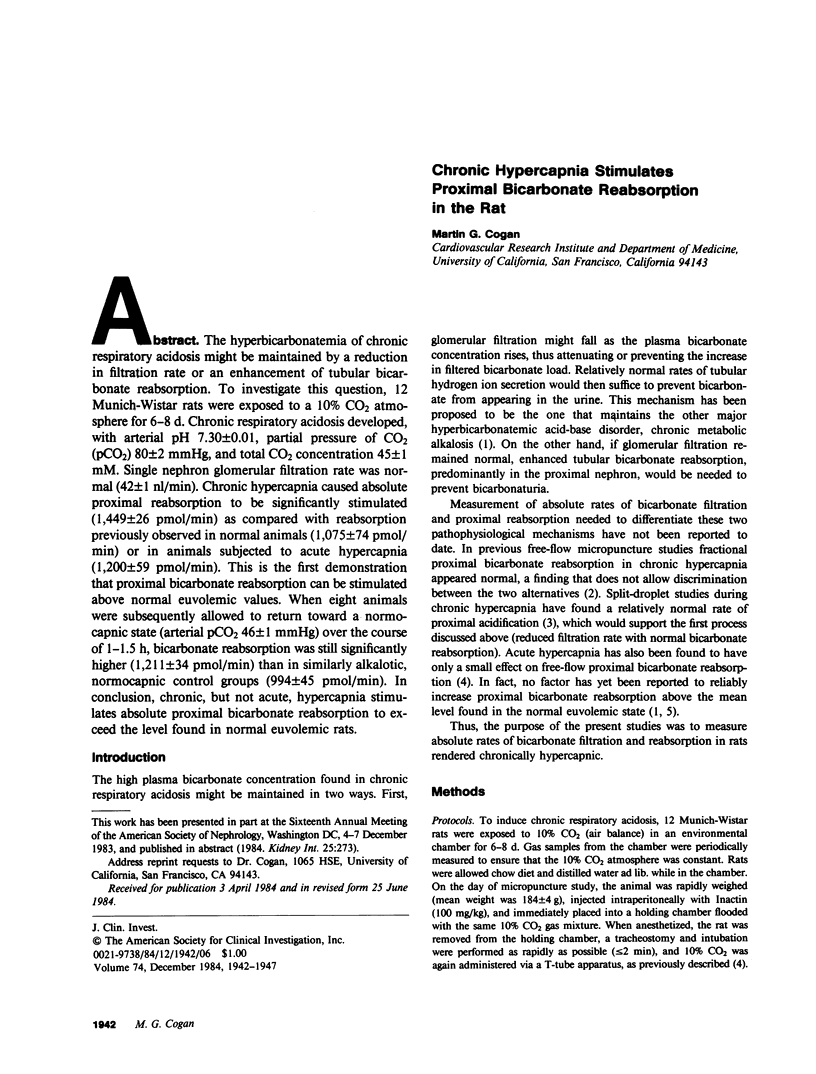
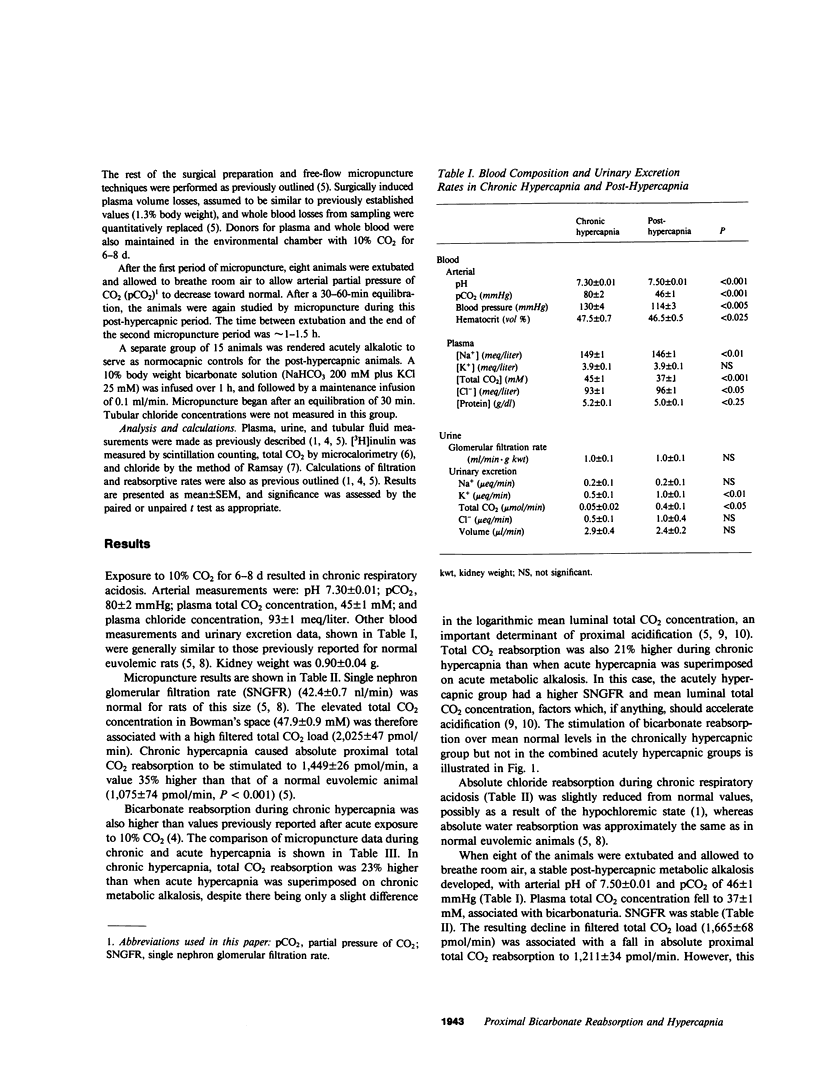
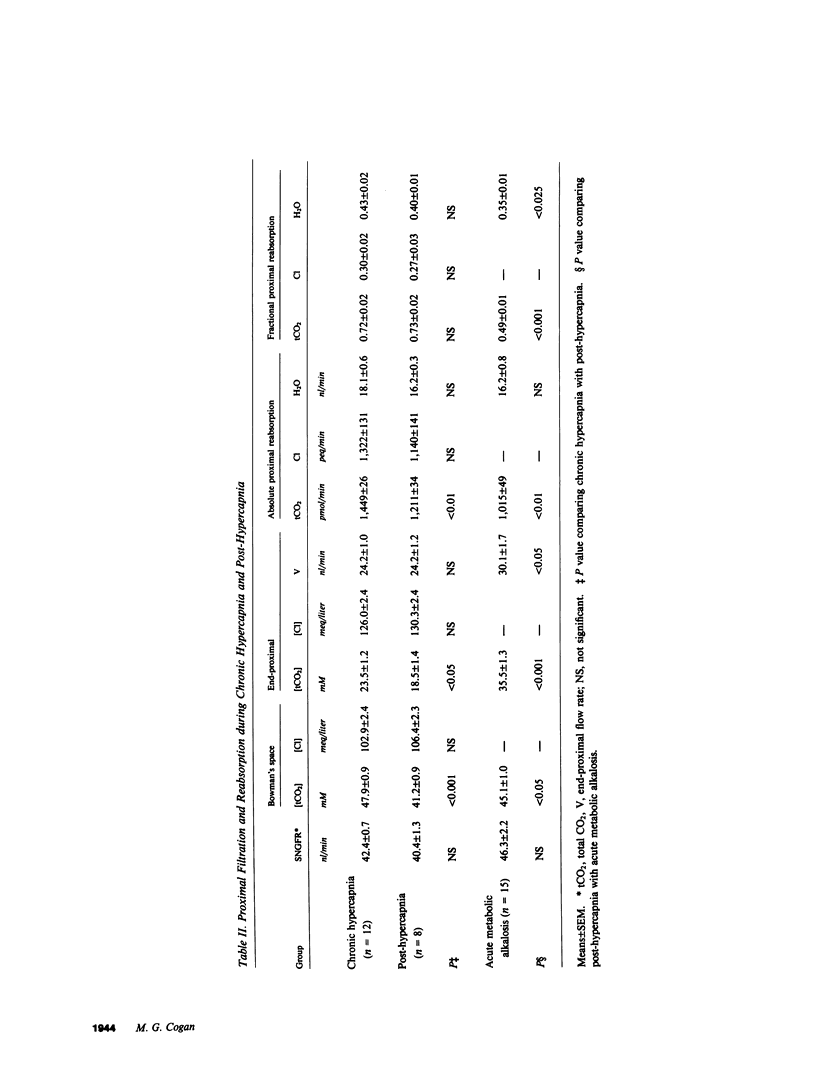
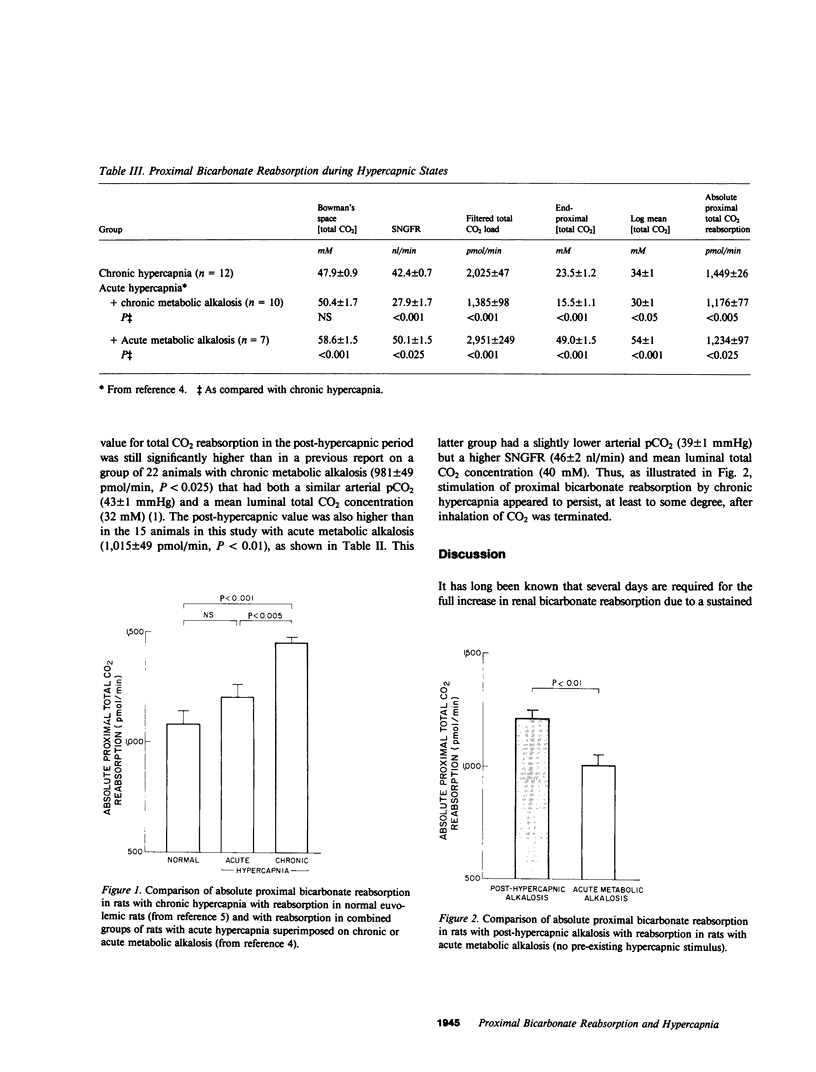
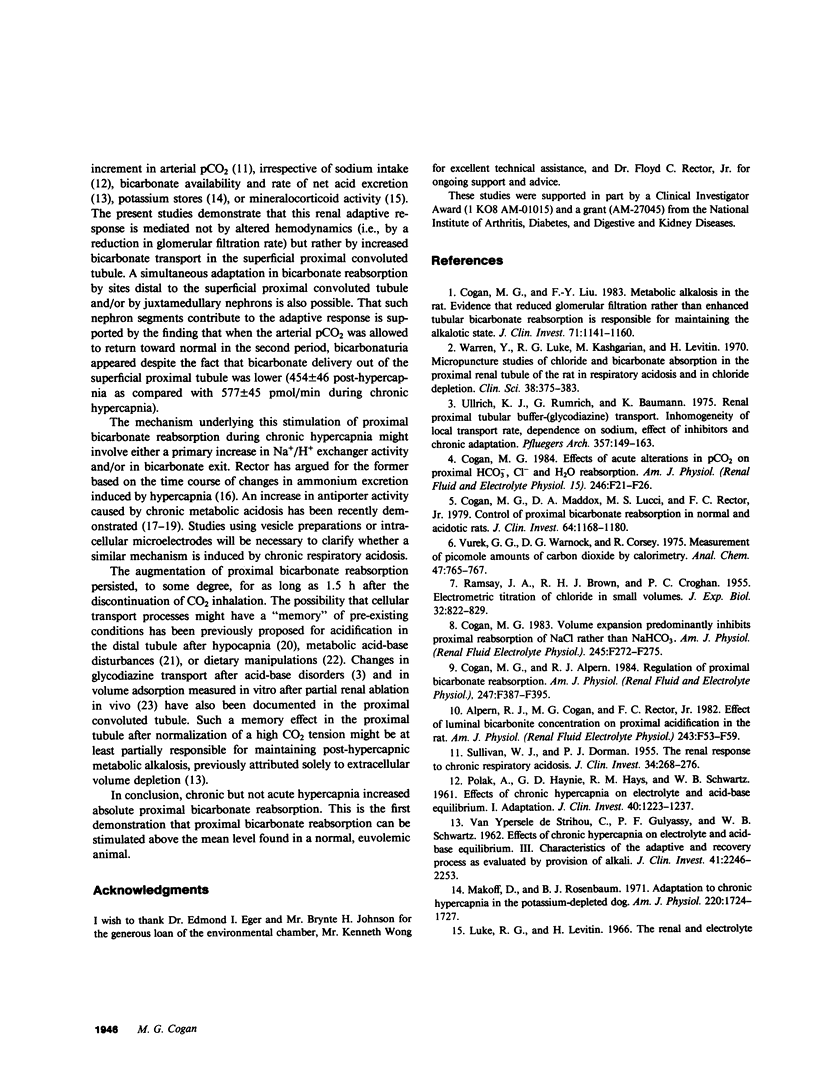
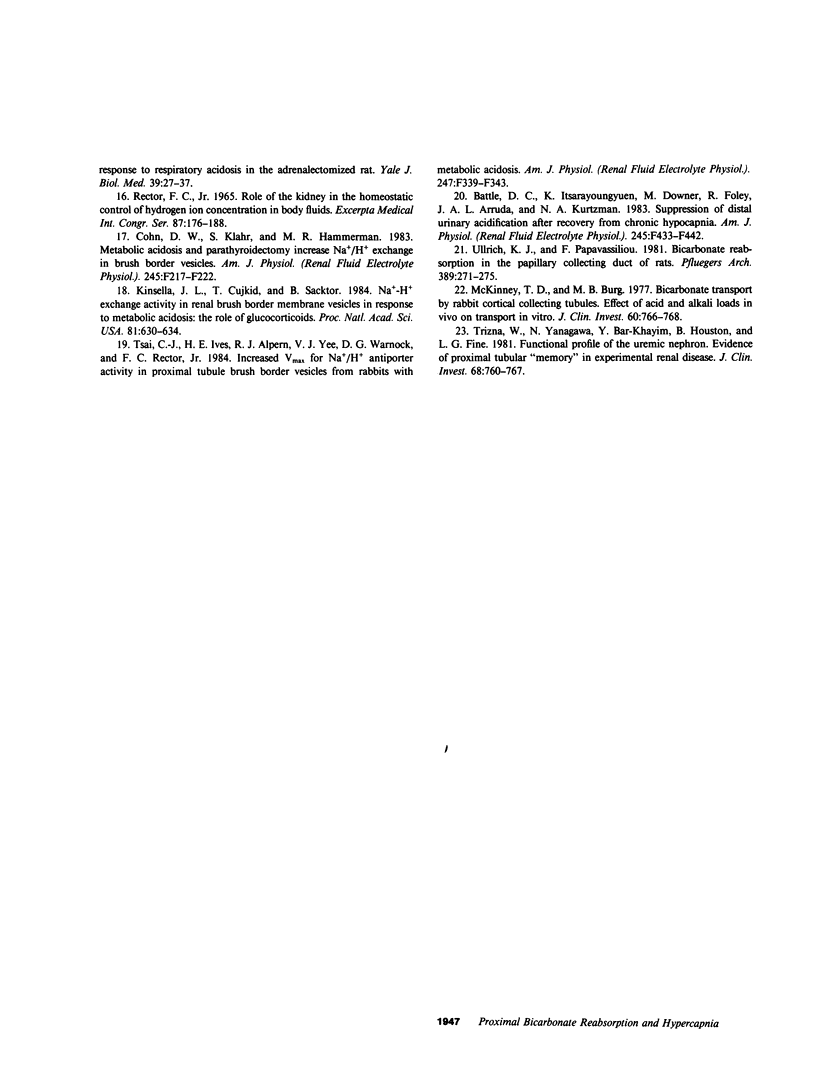
Images in this article
Selected References
These references are in PubMed. This may not be the complete list of references from this article.
- Alpern R. J., Cogan M. G., Rector F. C., Jr Effect of luminal bicarbonate concentration on proximal acidification in the rat. Am J Physiol. 1982 Jul;243(1):F53–F59. doi: 10.1152/ajprenal.1982.243.1.F53. [DOI] [PubMed] [Google Scholar]
- Batlle D. C., Itsarayoungyuen K., Downer M., Foley R., Arruda J. A., Kurtzman N. A. Suppression of distal urinary acidification after recovery from chronic hypocapnia. Am J Physiol. 1983 Oct;245(4):F433–F442. doi: 10.1152/ajprenal.1983.245.4.F433. [DOI] [PubMed] [Google Scholar]
- Cogan M. G., Alpern R. J. Regulation of proximal bicarbonate reabsorption. Am J Physiol. 1984 Sep;247(3 Pt 2):F387–F395. doi: 10.1152/ajprenal.1984.247.3.F387. [DOI] [PubMed] [Google Scholar]
- Cogan M. G. Effects of acute alterations in PCO2 on proximal HCO-3, Cl-, and H2O reabsorption. Am J Physiol. 1984 Jan;246(1 Pt 2):F21–F26. doi: 10.1152/ajprenal.1984.246.1.F21. [DOI] [PubMed] [Google Scholar]
- Cogan M. G., Liu F. Y. Metabolic alkalosis in the rat. Evidence that reduced glomerular filtration rather than enhanced tubular bicarbonate reabsorption is responsible for maintaining the alkalotic state. J Clin Invest. 1983 May;71(5):1141–1160. doi: 10.1172/JCI110864. [DOI] [PMC free article] [PubMed] [Google Scholar]
- Cogan M. G., Maddox D. A., Lucci M. S., Rector F. C., Jr Control of proximal bicarbonate reabsorption in normal and acidotic rats. J Clin Invest. 1979 Nov;64(5):1168–1180. doi: 10.1172/JCI109570. [DOI] [PMC free article] [PubMed] [Google Scholar]
- Cogan M. G. Volume expansion predominantly inhibits proximal reabsorption of NaCl rather than NaHCO3. Am J Physiol. 1983 Aug;245(2):F272–F275. doi: 10.1152/ajprenal.1983.245.2.F272. [DOI] [PubMed] [Google Scholar]
- Cohn D. E., Klahr S., Hammerman M. R. Metabolic acidosis and parathyroidectomy increase Na+-H+ exchange in brush border vesicles. Am J Physiol. 1983 Aug;245(2):F217–F222. doi: 10.1152/ajprenal.1983.245.2.F217. [DOI] [PubMed] [Google Scholar]
- Kinsella J., Cujdik T., Sacktor B. Na+-H+ exchange activity in renal brush border membrane vesicles in response to metabolic acidosis: The role of glucocorticoids. Proc Natl Acad Sci U S A. 1984 Jan;81(2):630–634. doi: 10.1073/pnas.81.2.630. [DOI] [PMC free article] [PubMed] [Google Scholar]
- Luke R. G., Levitin H. The renal and electrolyte response to respiratory acidosis in the adrenalectomized rat. Yale J Biol Med. 1966 Aug;39(1):27–37. [PMC free article] [PubMed] [Google Scholar]
- Makoff D., Rosenbaum B. J. Adaptation to chronic hypercapnia in the potassium-depleted dog. Am J Physiol. 1971 Jun;220(6):1724–1727. doi: 10.1152/ajplegacy.1971.220.6.1724. [DOI] [PubMed] [Google Scholar]
- McKinney T. D., Burg M. B. Bicarbonate transport by rabbit cortical collecting tubules. Effect of acid and alkali loads in vivo on transport in vitro. J Clin Invest. 1977 Sep;60(3):766–768. doi: 10.1172/JCI108830. [DOI] [PMC free article] [PubMed] [Google Scholar]
- POLAK A., HAYNIE G. D., HAYS R. M., SCHWARTZ W. B. Effects of chronic hypercapnia on electrolyte and acid-base equilibrium. I. Adaptation. J Clin Invest. 1961 Jul;40:1223–1237. doi: 10.1172/JCI104353. [DOI] [PMC free article] [PubMed] [Google Scholar]
- SULLIVAN W. J., DORMAN P. J. The renal response to chronic respiratory acidosis. J Clin Invest. 1955 Feb;34(2):268–276. doi: 10.1172/JCI103080. [DOI] [PMC free article] [PubMed] [Google Scholar]
- Trizna W., Yanagawa N., Bar-Khayim Y., Houston B., Fine L. G. Functional profile of the isolated uremic nephron. Evidence of proximal tubular "memory" in experimental renal disease. J Clin Invest. 1981 Sep;68(3):760–767. doi: 10.1172/JCI110312. [DOI] [PMC free article] [PubMed] [Google Scholar]
- Tsai C. J., Ives H. E., Alpern R. J., Yee V. J., Warnock D. G., Rector F. C., Jr Increased Vmax for Na+/H+ antiporter activity in proximal tubule brush border vesicles from rabbits with metabolic acidosis. Am J Physiol. 1984 Aug;247(2 Pt 2):F339–F343. doi: 10.1152/ajprenal.1984.247.2.F339. [DOI] [PubMed] [Google Scholar]
- Ullrich K. J., Papavassiliou F. Bicarbonate reabsorption in the papillary collecting duct of rats. Pflugers Arch. 1981 Mar;389(3):271–275. doi: 10.1007/BF00584789. [DOI] [PubMed] [Google Scholar]
- Ullrich K. J., Rumrich G., Baumann K. Renal proximal tubular buffer-(glycodiazine) transport. Inhomogeneity of local transport rate, dependence on sodium, effect of inhibitors and chronic adaptation. Pflugers Arch. 1975 Jun 26;357(3-4):149–163. doi: 10.1007/BF00585971. [DOI] [PubMed] [Google Scholar]
- VAN YPERSELE DE STRIHOU C., GULYASSY P. F., SCHWARTZ W. B. Effects of chronic hypercapnia on electrolyte and acid-base equilibrium. III. Characteristics of the adaptive and recovery process as evaluated by provision of alkali. J Clin Invest. 1962 Dec;41:2246–2253. doi: 10.1172/JCI104683. [DOI] [PMC free article] [PubMed] [Google Scholar]
- Vurek G. G., Warnock D. G., Corsey R. Measurement of picomole amounts of carbon dioxide by calorimetry. Anal Chem. 1975 Apr;47(4):765–767. doi: 10.1021/ac60354a024. [DOI] [PubMed] [Google Scholar]
- Warren Y., Luke R. G., Kashgarian M., Levitin H. Micropuncture studies of chloride and bicarbonate absorption in the proximal renal tubule of the rat in respiratory acidosis and in chloride depletion. Clin Sci. 1970 Mar;38(3):375–383. doi: 10.1042/cs0380375. [DOI] [PubMed] [Google Scholar]



